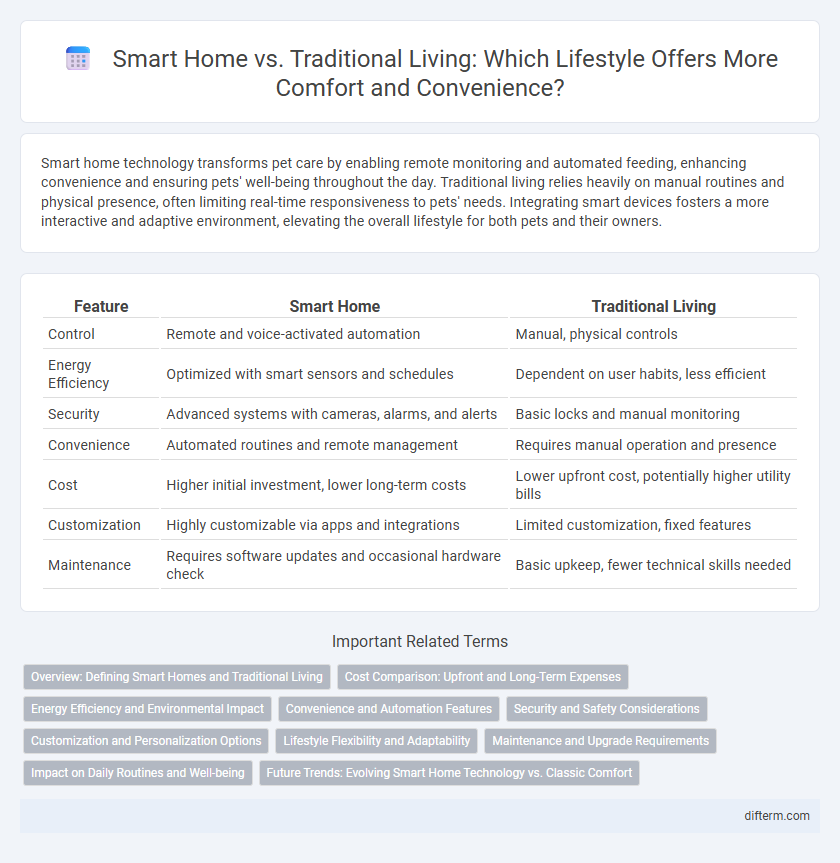Smart home technology transforms pet care by enabling remote monitoring and automated feeding, enhancing convenience and ensuring pets' well-being throughout the day. Traditional living relies heavily on manual routines and physical presence, often limiting real-time responsiveness to pets' needs. Integrating smart devices fosters a more interactive and adaptive environment, elevating the overall lifestyle for both pets and their owners.
Table of Comparison
| Feature | Smart Home | Traditional Living |
|---|---|---|
| Control | Remote and voice-activated automation | Manual, physical controls |
| Energy Efficiency | Optimized with smart sensors and schedules | Dependent on user habits, less efficient |
| Security | Advanced systems with cameras, alarms, and alerts | Basic locks and manual monitoring |
| Convenience | Automated routines and remote management | Requires manual operation and presence |
| Cost | Higher initial investment, lower long-term costs | Lower upfront cost, potentially higher utility bills |
| Customization | Highly customizable via apps and integrations | Limited customization, fixed features |
| Maintenance | Requires software updates and occasional hardware check | Basic upkeep, fewer technical skills needed |
Overview: Defining Smart Homes and Traditional Living
Smart homes utilize advanced automation systems and connected devices to enhance convenience, security, and energy efficiency, integrating technologies like voice assistants, smart thermostats, and automated lighting. Traditional living relies on manual control of household functions without interconnected technology, emphasizing simplicity and direct user interaction with appliances and home systems. The smart home ecosystem continuously collects data to optimize living environments, whereas traditional homes operate independently without real-time monitoring or adaptive functionalities.
Cost Comparison: Upfront and Long-Term Expenses
Smart home systems typically involve higher upfront costs due to smart devices, installation, and integration, whereas traditional homes generally require lower initial investment with standard appliances and fixtures. Over time, smart homes can reduce long-term expenses through energy efficiency, automated lighting, and security systems that lower utility bills and maintenance costs. Traditional living may incur higher recurring expenses from manual operation, repair, and energy consumption due to less optimized technology.
Energy Efficiency and Environmental Impact
Smart homes significantly enhance energy efficiency by integrating automated systems that optimize electricity and heating usage, reducing overall consumption compared to traditional living setups. Advanced sensors and smart thermostats adapt in real-time to environmental conditions and occupancy patterns, minimizing wasteful energy expenditure while lowering carbon footprints. This shift towards connected living environments promotes sustainable resource management, effectively decreasing environmental impact in residential spaces.
Convenience and Automation Features
Smart homes offer unparalleled convenience through automation features like voice-controlled lighting, climate regulation, and security systems that adapt to user preferences in real-time. Traditional living lacks these integrated systems, requiring manual adjustments for everyday tasks. The efficiency and seamless user experience in smart homes significantly enhance daily lifestyle comfort and time management.
Security and Safety Considerations
Smart home systems enhance security by integrating advanced sensors, real-time monitoring, and automated alerts, reducing response times to potential threats compared to traditional living setups. Features like remote access control, AI-powered surveillance cameras, and smart locks improve safety by preventing unauthorized entries and enabling immediate intervention. In contrast, traditional homes often rely on manual locks and alarm systems, which may lack real-time connectivity and predictive threat detection.
Customization and Personalization Options
Smart homes offer extensive customization through AI-driven devices and integrated systems that adapt to individual preferences, enhancing comfort and efficiency. Traditional living spaces lack the dynamic personalization capabilities, relying on manual adjustments and fixed setups. Advanced smart home technology enables tailored environments that adjust lighting, temperature, security, and entertainment according to user habits and real-time data.
Lifestyle Flexibility and Adaptability
Smart home technology enhances lifestyle flexibility by allowing users to customize and control their living environments remotely through integrated devices and automation systems. Traditional living often lacks this adaptability, requiring manual adjustments and limiting responsiveness to changing needs or preferences. Advanced smart homes support seamless adaptation to routines, energy usage, and security, enabling a more dynamic and efficient lifestyle.
Maintenance and Upgrade Requirements
Smart homes require regular software updates and occasional hardware upgrades to maintain system efficiency and security, unlike traditional homes that primarily depend on manual upkeep of physical components. Maintenance in smart homes often includes troubleshooting connectivity issues and updating firmware, which demands technical knowledge or professional assistance. Traditional living focuses on routine repairs and replacements of structural elements, which tend to be less frequent but more labor-intensive.
Impact on Daily Routines and Well-being
Smart home technology streamlines daily routines by automating tasks like lighting, temperature control, and security, reducing physical effort and saving time. Enhanced home environments with personalized settings contribute to improved sleep quality, stress reduction, and overall well-being. In contrast, traditional living requires manual management of household activities, which can increase daily stress and limit opportunities for relaxation and health optimization.
Future Trends: Evolving Smart Home Technology vs. Classic Comfort
Evolving smart home technology integrates AI-driven automation, energy-efficient systems, and advanced security features, transforming traditional living spaces into intelligent environments that adapt to user preferences. Future trends highlight seamless connectivity through IoT devices, voice-controlled assistants, and predictive maintenance, offering enhanced convenience and sustainability. Classic comfort remains valued for its simplicity and familiarity, but the rise of smart home innovations promises personalized, efficient lifestyles that redefine everyday living.
smart home vs traditional living Infographic

 difterm.com
difterm.com